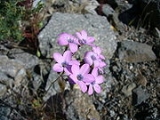
Gilia latiflora
Encyclopedia
Gilia latiflora is a species of flowering plant in the phlox family
known by the common names hollyleaf gilia and broad-flowered gilia. It is endemic to California
, where it grows in the deserts and mountains of the southern part of the state.
s directly up from the ground.
Each multibranched inflorescence is green to reddish in color and approaches half a meter in maximum height. These are topped with fragrant flowers one to three centimeters across. Each flower is lavender to purple with a white throat from which protrude a long style
and several shorter stamen
s.
Polemoniaceae
Polemoniaceae are a family of about 25 genera with 270-400 species of annual and perennial plants, native to the Northern Hemisphere and South America, with the center of diversity in western North America, especially in California.Only one genus is found in Europe, and two in Asia, where they...
known by the common names hollyleaf gilia and broad-flowered gilia. It is endemic to California
California
California is a state located on the West Coast of the United States. It is by far the most populous U.S. state, and the third-largest by land area...
, where it grows in the deserts and mountains of the southern part of the state.
Description
Gilia latiflora adds lavender to the colorful carpet of spring wildflowers on the sandy washes of the region. The plant starts from a basal rosette of frilly leaves, each of which is made up of many narrow-toothed lobes. The stem is generally too small to notice; instead the plant is scapose, sending stemlike inflorescenceInflorescence
An inflorescence is a group or cluster of flowers arranged on a stem that is composed of a main branch or a complicated arrangement of branches. Strictly, it is the part of the shoot of seed plants where flowers are formed and which is accordingly modified...
s directly up from the ground.
Each multibranched inflorescence is green to reddish in color and approaches half a meter in maximum height. These are topped with fragrant flowers one to three centimeters across. Each flower is lavender to purple with a white throat from which protrude a long style
Gynoecium
Gynoecium is most commonly used as a collective term for all carpels in a flower. A carpel is the ovule and seed producing reproductive organ in flowering plants. Carpels are derived from ovule-bearing leaves which evolved to form a closed structure containing the ovules...
and several shorter stamen
Stamen
The stamen is the pollen producing reproductive organ of a flower...
s.

